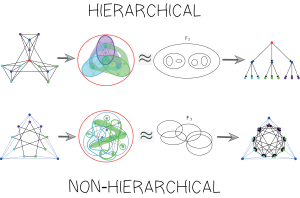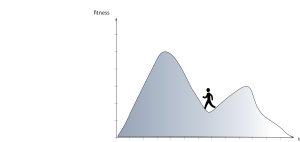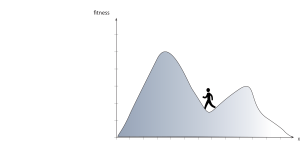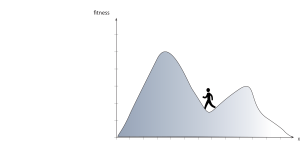Evo
Mathematical anarchism
Root out power so that freedom can flourish wildly
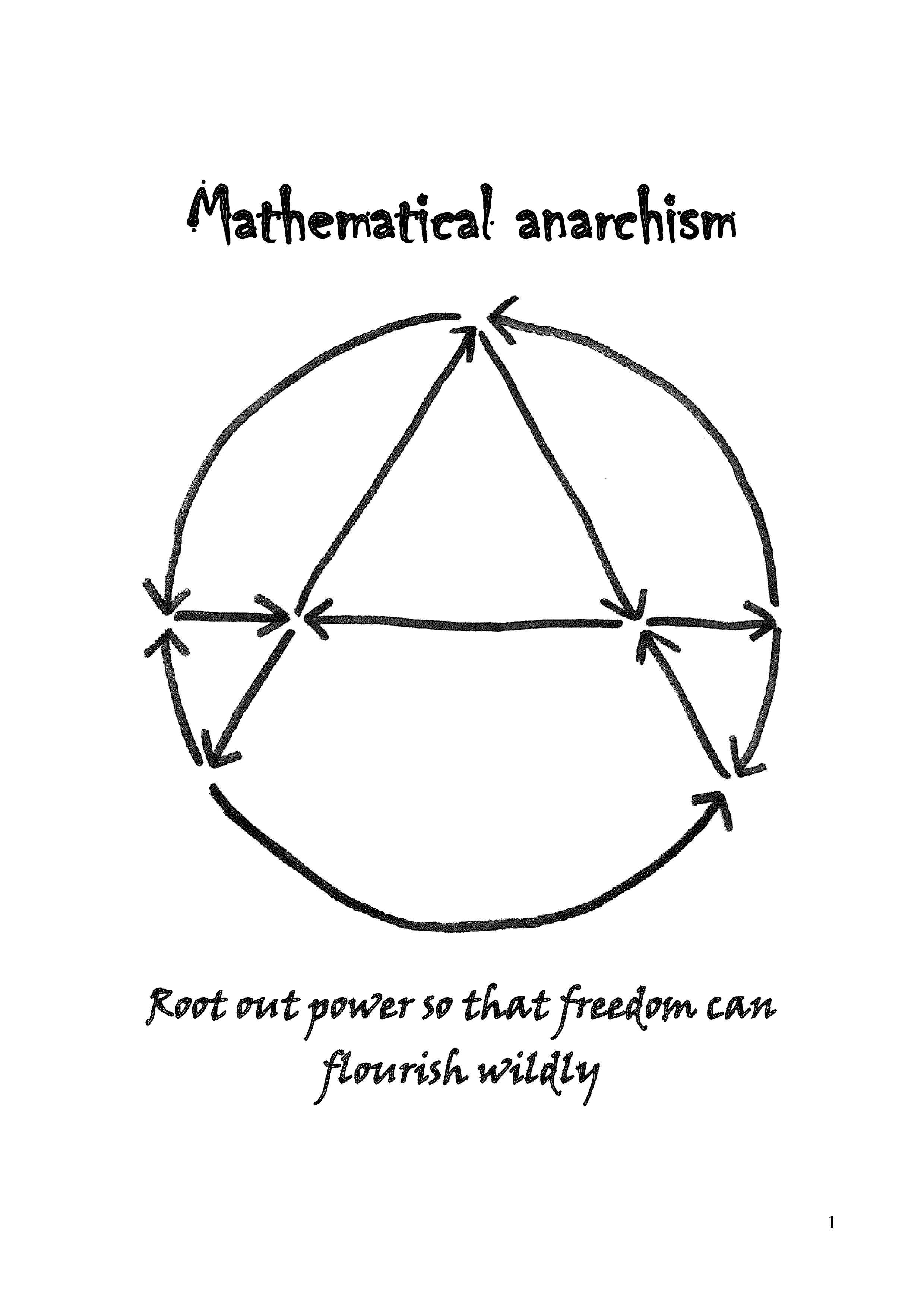
Formation of a control mechanism
Determination and co-evolution
All-over I search the answer to three questions in this booklet, which are about respectively the what, the origin and the future. The what-question is about what hierarchy on the one hand, and freedom on the other, is. The second question is how hierarchy can emerge, while the last, most interesting question deals with how we can move away from this and create a free society.
This by aiming to go to the root of the matter and dissect some underlying concepts and mechanisms.
This booklet is based on my PhD “Self-organization versus hierarchical organization — a mathematical investigation of the anarchist philosophy of social organization”
Any feedback – comments, questions, ideas, errors, remarks,…? Or want to see more?
mathematicalanarchism.wordpress.com
Okay, how did I come to this idea of combining anarchism with mathematics?
To me it was to some extent a natural combination, as I’ve always been passionate about both mathematics and anarchism. I have a problem with authority, with power, and with everything that restricts my freedom or coerces me. And thus I want to find out how we can create a world where no (or less) coercion is present.
But by thinking about this, I came to the conclusion that these concepts are less easy to define than I thought. Also because in today’s world, coercion is often less explicitly visibly than before, where there was a clear hierarchical structure with, for example, a king on the top of the pyramid. Today the source of a perceived lack of freedom is less easy to find. For example, technology creates alienation and addiction: we have thousands of friends in Facebook, but lack true, deep connection. We work nine-to-five in a boring job to make a living. Nobody who forces us to do so, and still we have the feeling our lives aren’t in our own hands.
And to understand these things better, I turn to math, or wiskunde in Dutch, which you could translate literally as the art of erasure. To me, math is about going to the essence, to distil common mechanisms, relevant to your question, out of a bunch of phenomenons. By simplifying to basic concepts, you can go further: you can let your imagination go wild on them, and construct things which would be way to complicated when starting from the messy reality. And these imagined concepts can be brought back to reality, to make dreams come true there. Radically going to the root of things, so that freedom can grow wildly.
But you don’t have to be a math whiz to understand this booklet. Math is more the underlying way of thinking, as in how I explained it above. With my mathematical, abstract, systematic brain I took a look at anarchist ideas, which resulted in new notions which are hopefully also interesting for the non-mathematician (and which are not always mathematical).
I’ve put specific mathematical elaboration in special Yeah, math! -boxes – these are not necessary to understand the whole and can thus be skipped. And then there are the A story: -boxes, in which I give examples of just seen concepts.
The footnotes refer to a work on which that part is based, no need to stop your reading unless you want to check out more.
A common thread throughout this booklet is the difference between a hierarchical structure and different connected cycles. After explaining this difference, I’ll explain how it corresponds with a functional difference between hierarchy, power, coercion, external coercion on the one hand, and freedom, autonomy, internal control on the other. After that, I dive deeper into the structural with other possible representations of (non-) hierarchical structures, and explain why they are just different depictions of one and the same concept.
Then we discuss how a higher-order controller can emerge. To finally suggest some ideas on how we can evolve to a free society, more alike to the living, cyclical of an ecosystem, and not based on hierarchical, authoritarian state structures.
But not all my ideas can be spanned under this common thread. Precisely because they do not form a hierarchical structure with one main idea and different subordinate sub-ideas. The ideas link between each other, they can form cycles, where one idea strengthens another, but the last idea in the end also supports the original idea. That may make it difficult to follow (since to understand one part completely, you should actually already have read a further part), but it also makes that you can read in any order you want. So maybe you are mainly interested in how to increase your freedom, go and jump then directly to that chapter.
Common thread
The differences between a hierarchical and a cyclical structure can be illustrated in following figure:
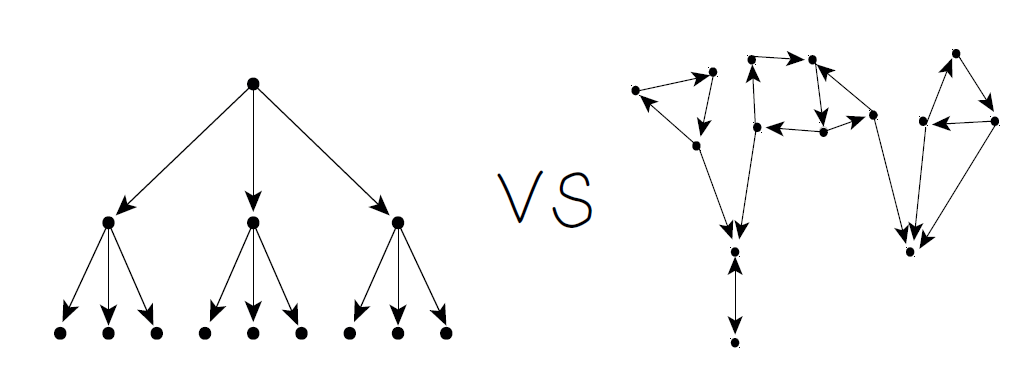
One of the things that stand out in the left, hierarchical figure, is that there is an anti-symmetry: an arrow always goes from a ‘top’ element to a ‘bottom’ element, never in the other direction. This happens directly – there can only be an arrow between two elements in one direction – as well as indirectly – if an element A is connected through different arrows with an element B, there can be no arrow from B to A. In the alternative, if this does happen, they are automatically cycles: through different arrows we in the end arrive back at the original element.
Another property from the hierarchical figure is that there is maximal one arrow arriving at each element, while often different arrows depart from it. On the other hand, in the right, non-hierarchical figure arrows from different elements can arrive at one element.
These two properties of a hierarchy cause a tree structure. We can prove that there is only one top element if these two properties are valid and the structure is finite.
In the following I will describe the left situation as hierarchy, while I’ll talk about (entangled) cycles for the right situation (where I thus assume that there also arrive different arrows).
Yeah, math!
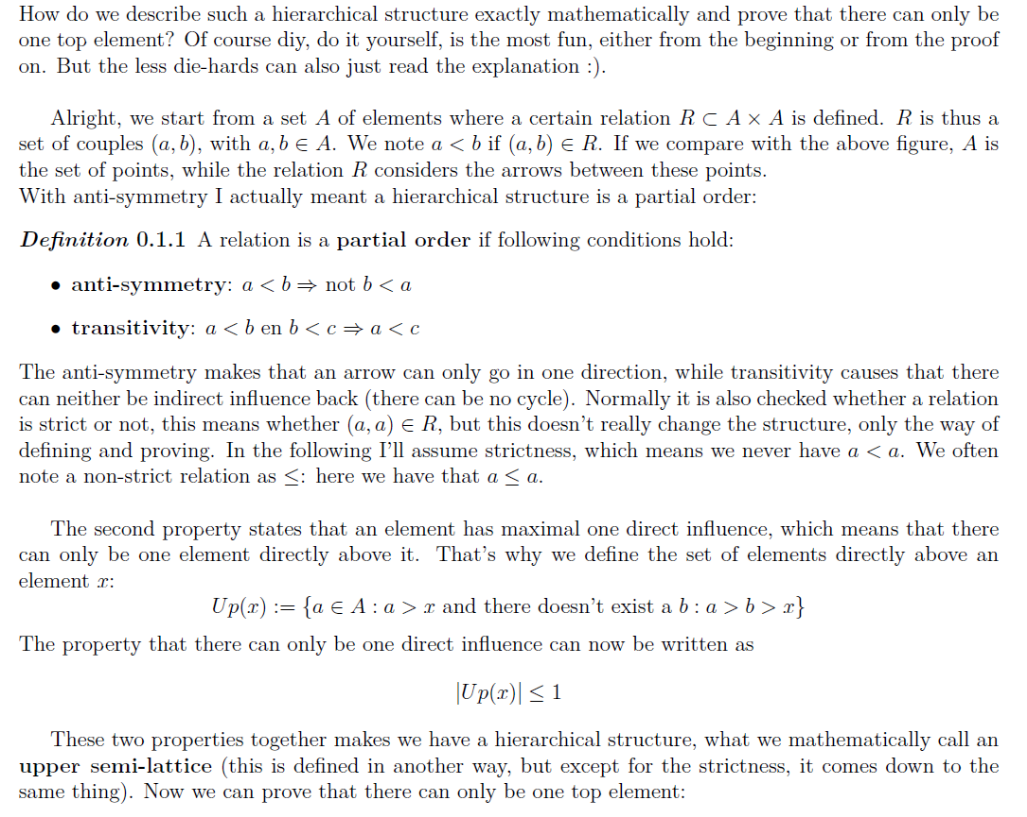
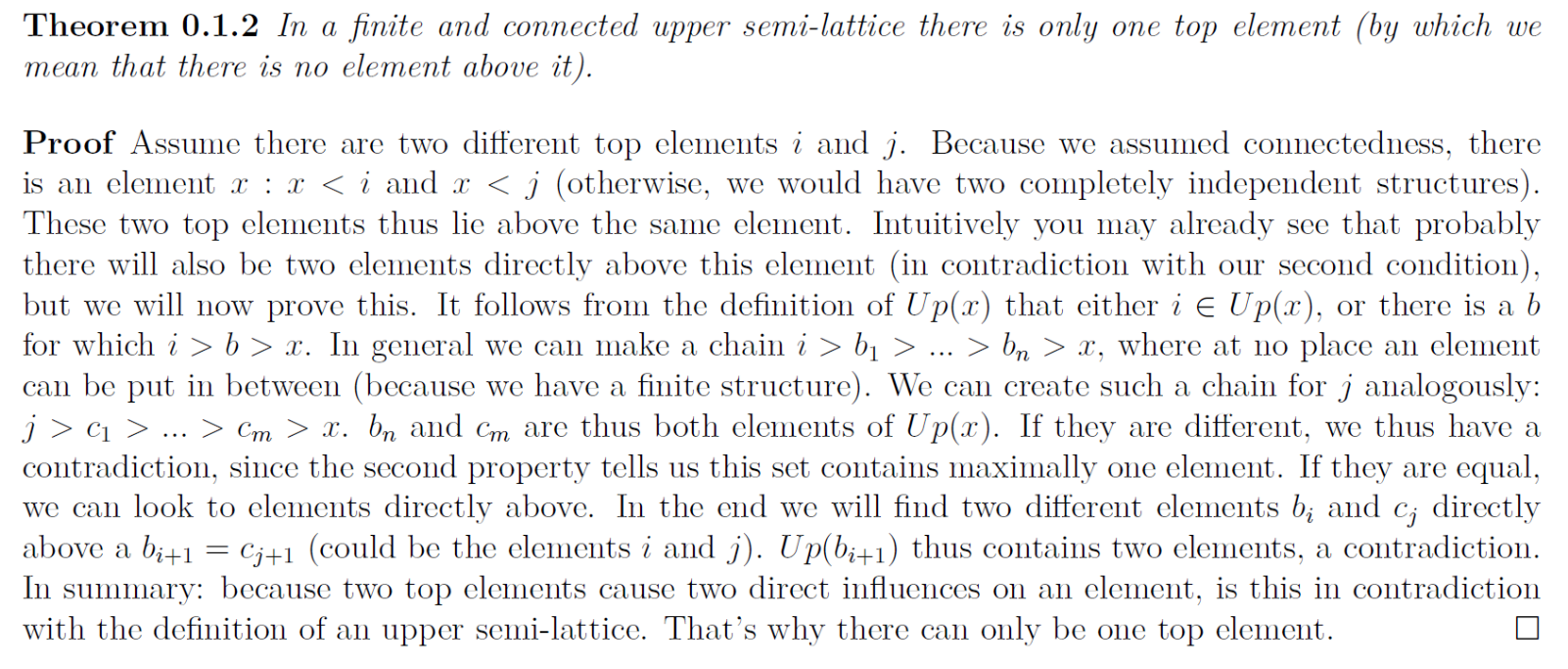
What?
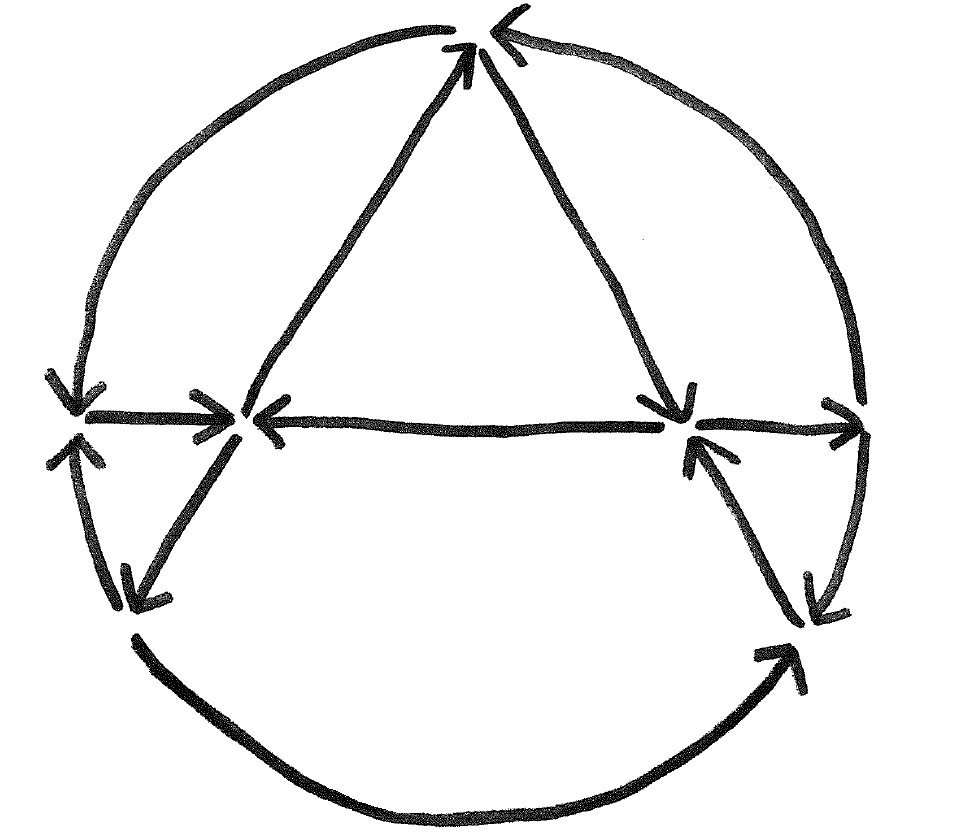
Self-creation
All of this probably sound abstract, what does this entail concretely? The easiest to imagine, is to view these arrows as influence, as a cause-effect relation.
Anti-symmetry then means that influence only goes in one direction, what’s sometimes defined as power-over: someone has influence over you while you don’t have influence back. A power relation thus, but different from power-to, the power to accomplish things.
If moreover you can maximally have one influence, you can be completely determined by that influence.
If on the contrary there are multiple inputs, you can form a creative combination of them, more than the sum of the inputs – thus a sign of a lack of hierarchy.
A story:
Nurture-vs-nature debate on gender: neither, but self-creation
An often heated discussion, especially on the topic of gender, is whether we are influenced by nature or nurture: are men and women biologically determined to act differently or is this conditioned by society? One of the reasons I think this discussion is so heated, is because both parties feel their free will is denied. The ones say you should take certain roles because of your biology. The others claim we are just a product of culture, independent of our own make-up.
Self-creation is a way out of this deadlock: we have created ourselves from both biological and cultural influences. We can partly decide ourselves who we want to be and what we want to do and thus have a free will. Though you shouldn’t deny that culture thus influence you, just like you have a certain biological base (but one more diverse than a simple X or Y chromosome).
To me, transgenders are proof that there is something more at play than nature or nurture. Because both your biology as society can say that you are, for example, a girl, and still you can know that you are a boy (or something else). It is not that it is merely a choice: a complex system has formed, which has its own identity that is not merely determined by the influences that have created it.
On a fundamental level, cycles make that there can be self-causation, where we can cause our own existence, inputs are getting created from outputs. Sure, we cannot just pop out from nowhere, but once we are there, we can maintain ourselves, and set and follow our own goals. We are autonomous and can create ourselves. A fancy word for this concept is autopoiesis (auto=self, poiesis=creation), which we, for example, assess in all living beings [1].
Note that usually there is not one isolated cycle, but different entangled cycles. Where there can thus be different influences working on one element, which can give a unique, unpredictable consequence, making the system dynamic. The different cycles form a complex system, where we unravel two properties linked with autopoiesis. The first is that the system can maintain itself: everything that is used by the system, is produced by the system in at least as much. Secondly, the system is closed: everything that gets produced, was already part of the system.
Yeah, math! [7]
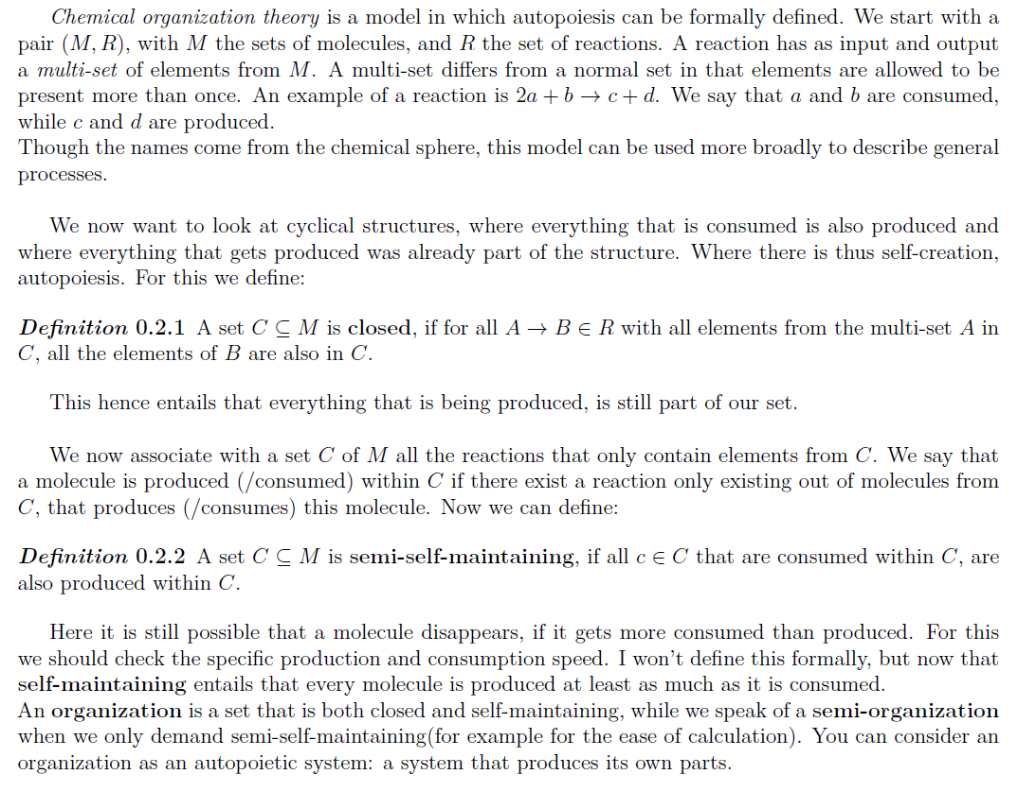
But in practice there are still influences from the environment. But in an autonomous system, the system itself decides what to do with those influences and can decide its path independent of these influences.
This is in general what cybernetics describes as control: a feedback cycle where a controller does certain actions to get its input closer to its goal – see following figure. I will often have such scheme in mind when speaking about an agent or an autonomous system.
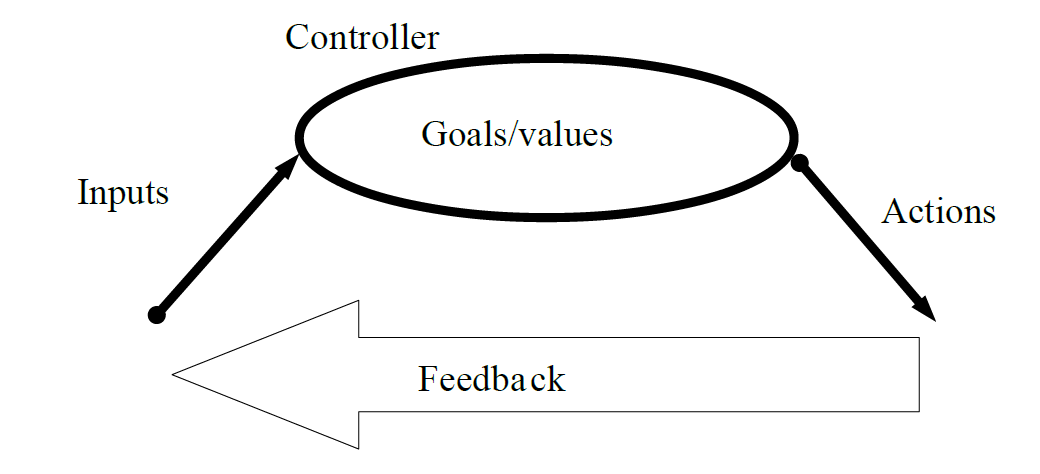
To investigate the effect of different influences on a result, I differentiate internal and external control. Internal control is if a change of your influence can cause a change in the result (we specifically mean the result important for you; this typically relates to your goals and/or the inputs you will receive). While there is external control if an external influence brings a change in the result. In itself the one doesn’t exclude the other, but do be autonomous we mainly want internal control: we want to be able to decide our own path.
Take as example the external influence of the wind. Most objects simply fly along the wind and thus have little internal control. But a good cord dancer can continue to follow his path on the cord, despite the wind bringing him out of balance, by doing counter movements. A sailor can even use the wind to go in any direction, even against the wind (by zigzag). Still the wind just keeps on blowing, and we don’t change its direction by our deeds. But the cord dancer can also lose its equilibrium, in which case it no longer has internal control.
A story:
Parkour
Parkour is an example where internal control is increased without changing the environment. In parkour, walls and everything found in an often urban environment become challenges which can be jumped and climbed over, on and under. Parkour is more than a sport, it is a philosophy.
The environment doesn’t change, but parkour does change the perception of the environment. Walls are no longer obstructions that block your way, but challenges to do new movements. Parkour is about creating your own path instead of following a predetermined path. This philosophy can be applied more broadly than literally. Obstacles that you encounter in life can be seen as challenges, chances for growth and gratification. The world becomes a playground. Your world thus no longer looks the same after doing parkour.
Of course you still want an interesting world, thus not a plain without hindrances or one with insurmountable walls. But even there the art of parkour is to nevertheless find challenges.
Parkour shows that external control isn’t necessary to deviate from the predetermined path.
You could also look at it from the perspective of your influence on the environment: how hard do you want to change the environment to have control? With internal control the focus is then on your own situation, while with external control you mainly want control over your environment. In the example of the wind: we could develop ways to go to the wanted direction independent of the direction of the wind (internal control), or we could try to control the direction of the wind (external control).
Yeah, math!
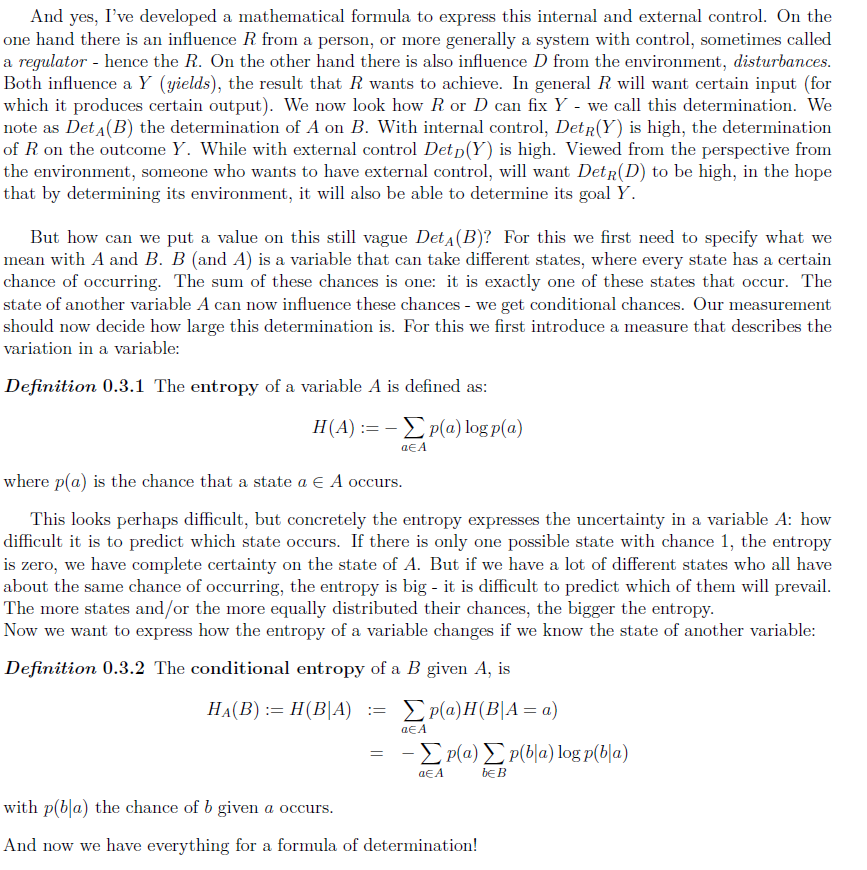
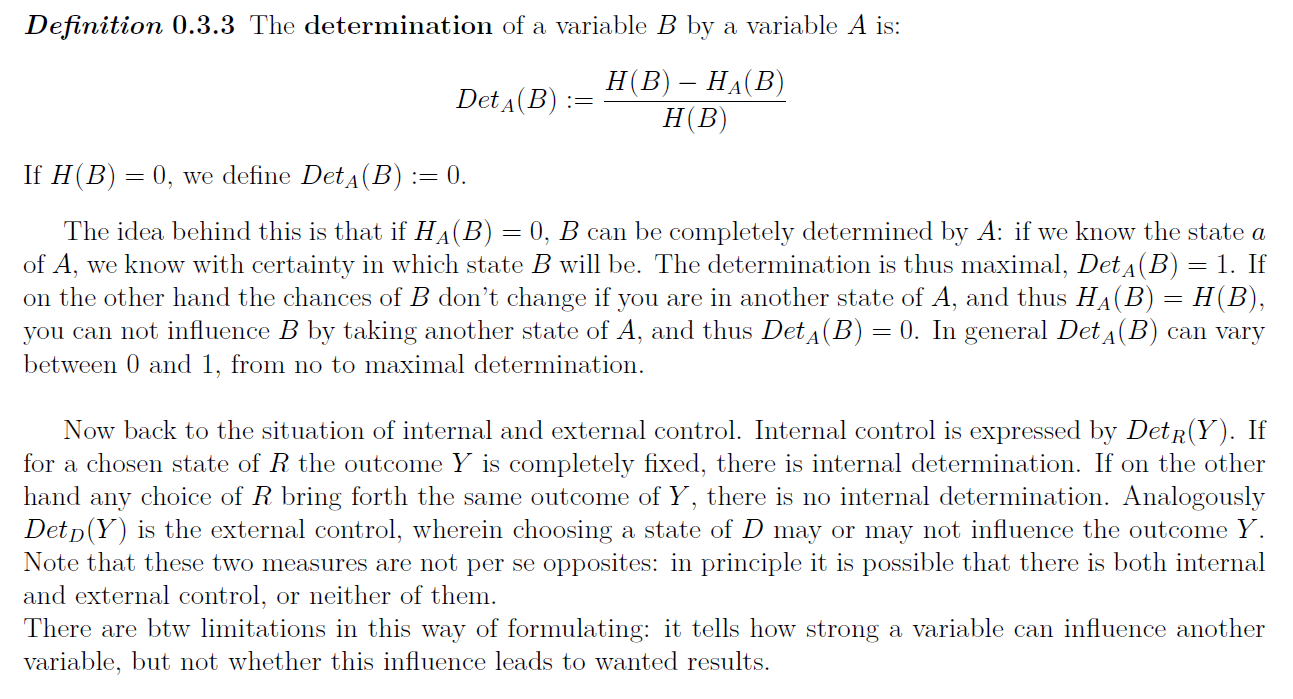
Freedom
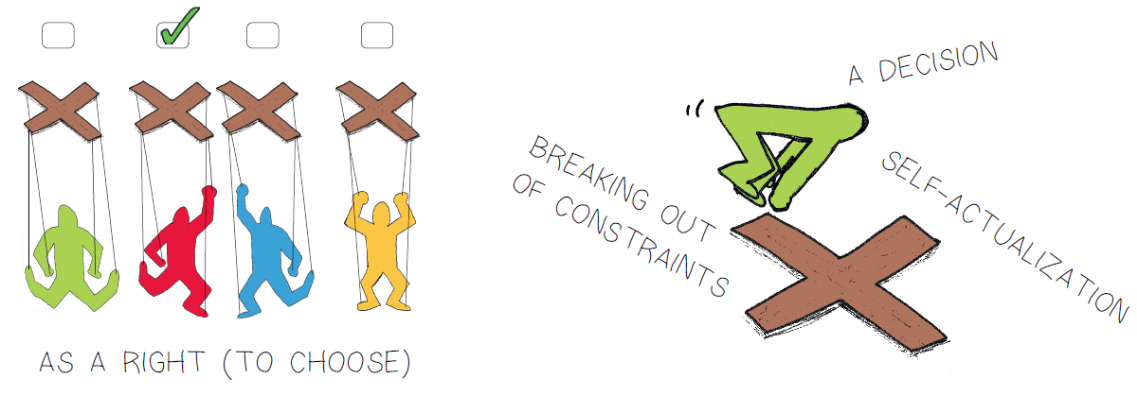
Roughly, freedom is understood in two distinct ways. Underlying in the first conception is the cycles: freedom is here linked with autonomy, self-creation. Here freedom can only be taken or created by yourself. Freedom here means spawning your own possibilities, to break out of existing constraints. It is a conscious decision, and not something you can simply get. The focus can be more on the negation of coercion and constraint, or more on the positive of developing and actualizing yourself.
Another perspective starts from a hierarchical thinking: here freedom is something that can be given from outside, a right. This is typically the freedom in a democracy, think about freedom of speech, freedom of association, … In general, this is the freedom to choose from already pre-given options. This is the capitalistic freedom where you can choose the colour of your coffee machine.
Coercion and constraint
What is it then exactly that hinders this freedom? Therein I differentiate two concepts, which are often used interchangeably: coercion and constraint. Coercion is if you are obliged to do something you do not really want to do. Constraint is what limits possibilities. Often this is viewed mathematically as a precondition, something that reduced a set (of solutions). Actually, there are always constraints, otherwise we would simply float around in a random soup of loose particles – it makes us exist at all. In short, it makes the world interesting.
Constraints aren’t necessarily coercive. Moreover, as soon as we choose for ourselves to go into a certain direction, we put a constraint on ourselves. And exactly this possibility could be seen as why we are autonomous, free individuals.
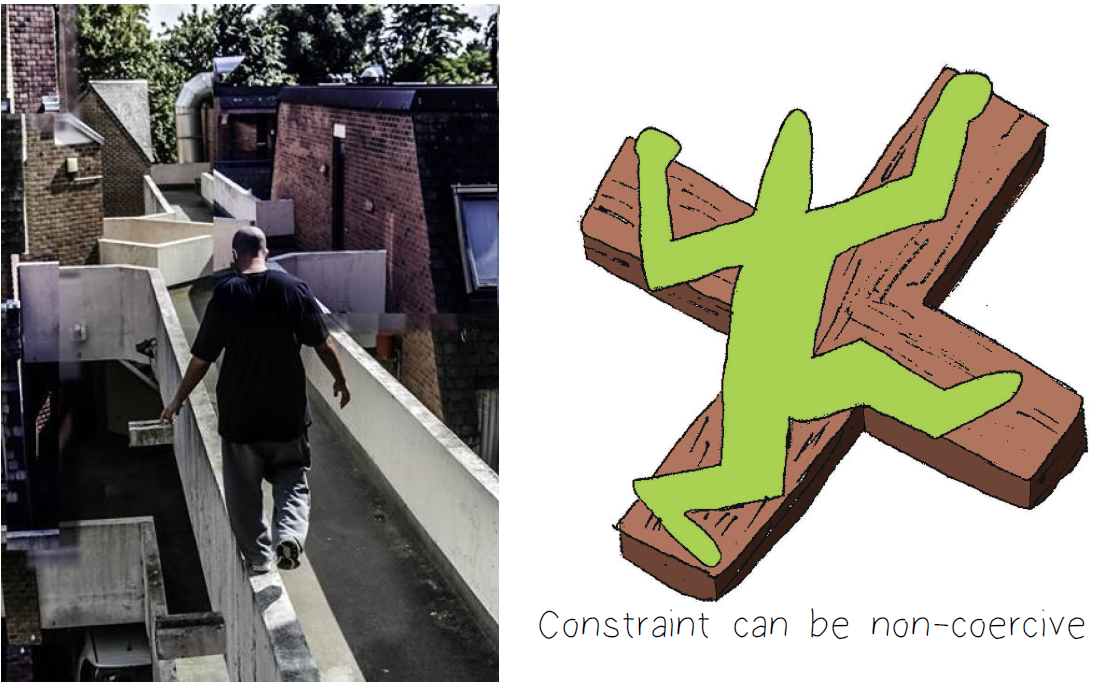
On the other hand, coercion can increase your options. You could be forced to do something you would otherwise never do, cancelling some constraints. A soldier could for example be sent to the other side of the world and thus discover all kinds of countries and experiences he would otherwise never have encountered.
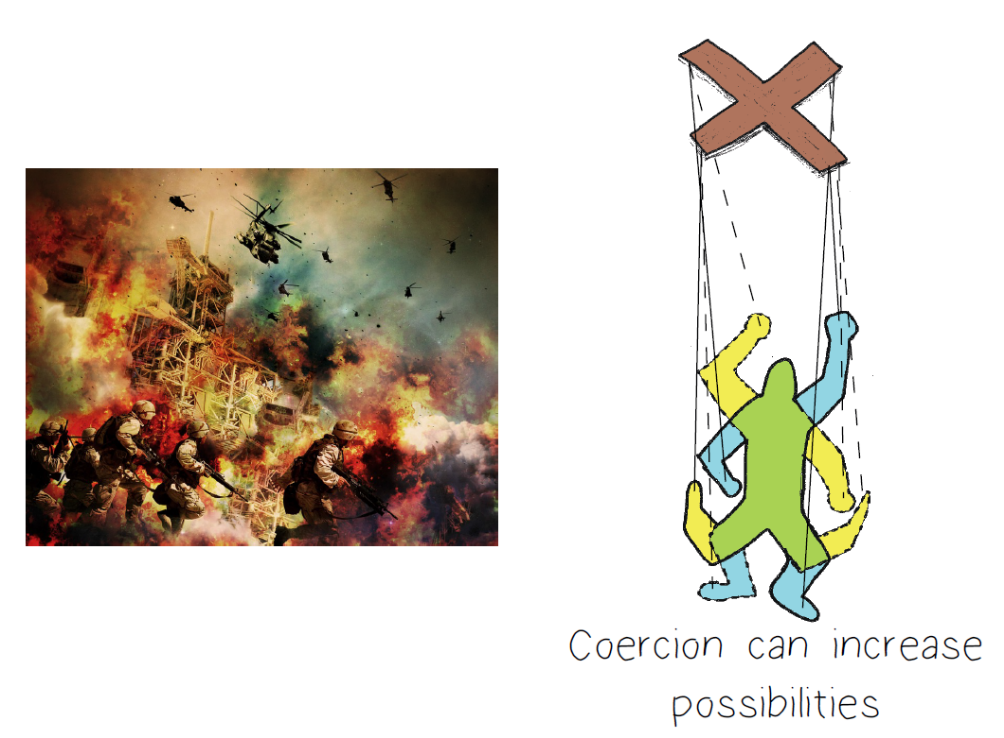
Coercion sounds like a better concept to name the lack of freedom we want to speak about. Only: it is not that easy to decide when someone is coerced. The “will” or goals of someone can’t be assessed directly, we can’t look inside someone’s head. Therefore, the will (or a goal) is often defined based on what you do: if you put a lot of effort into achieving a certain situation, it is assumed that situation is a goal of you. But if you assume what you do is a direct consequence of what you want, then you can impossibly do something you do not want. And then coercion is an impossibility.
These philosophical reflections in the difficulty of knowing when someone is coerced, translate to practice. Addiction is a typical example of what is at play here: for the outside world a person can do things that are not the best for him, and thus be addicted, while the person himself doesn’t see the problem (or hides it for herself), and still sees it as something positive. Such a mechanism can be recognized more broadly than purely in the addiction to drugs.
Often there is a dependence – one is dependent of an outside source to provide for certain needs. A dependence makes you vulnerable for coercion, because that external source can expect certain things in exchange for the demands you need. But in itself, the input from an external source can also be wanted. In general, there is determination – an external source decides your output (/input) instead of yourself.
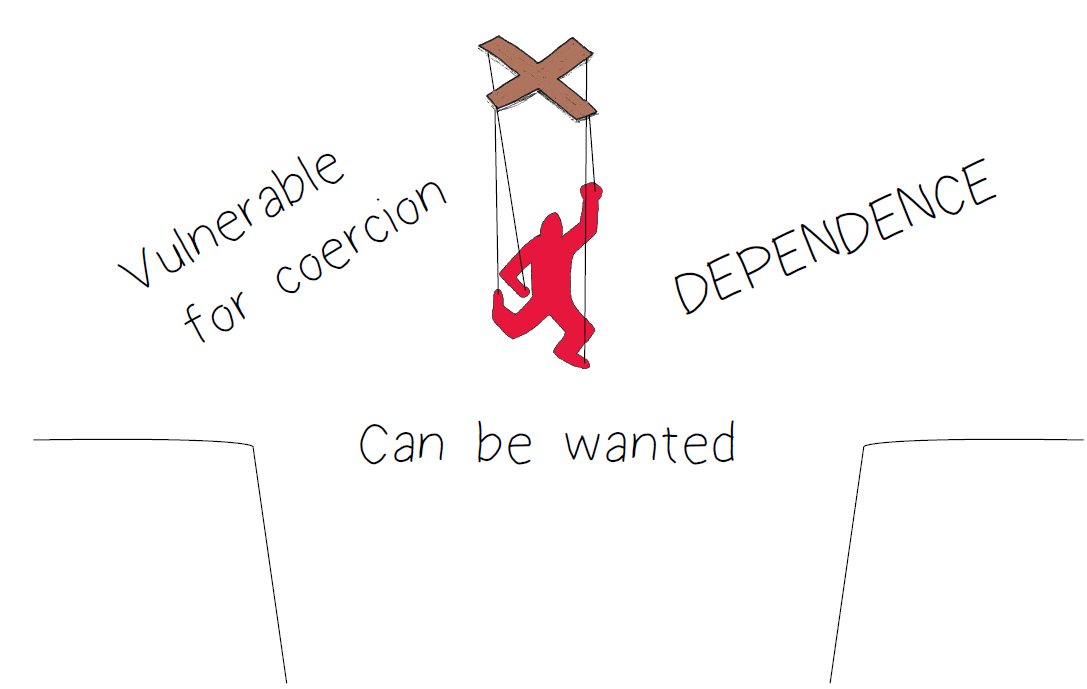
Consequences determination
Structure
We can now discuss the structural side of hierarchy.
We already discussed a first representation in the beginning, remember this figure:

Here we have a structure with arrows, which is why we speak about directed networks. In this case, a hierarchy means anti-symmetry and maximally one influence per element, while a non-hierarchical structure exists out of cycles where elements can have multiple influences.
Of course in practice these structures are in between these two extremes. We can thus look to how hierarchical a certain structure is: how many elements are part of a cycle, how much influence do these cycles have on the overall structure, and whether multiple arrows leave or arrive in an element[2].
Other mathematical types in which we can investigate hierarchy, are sets and undirected networks.
If we look to sets, hierarchy is presented by a big set with smaller sets in it, where every smaller set contains in itself even smaller sets, and so on. Think about a country with several regions, where every region contains different communes, and every commune exists out of several households. Typically is that every group has someone as head who represents the group: the prime minister, the first minister of the regions, the mayor, the householder. In a non-hierarchical structure on the other hand, there are different groups that overlap, none containing the other – you are, for example, in a sport club, you have a group of friends from the past, you have a group of colleagues, a family,… Some people from your sport club will, for example, also be in your group of friends, but both contain persons that are not in the other group.
In fact this is just another way of representing structures, and hierarchy here is the same as hierarchy in the directed networks of before. We can consider that a set ‘influences’ another set if there is overlap between them, and the first has elements which are not in the second. Then we can define a link from the one set to another. In the hierarchical case we see that the bigger set influences the smaller sets under it, and we thus get a tree structure. In the non-hierarchical case there is mutual influence between overlapping sets, and thus cycles.
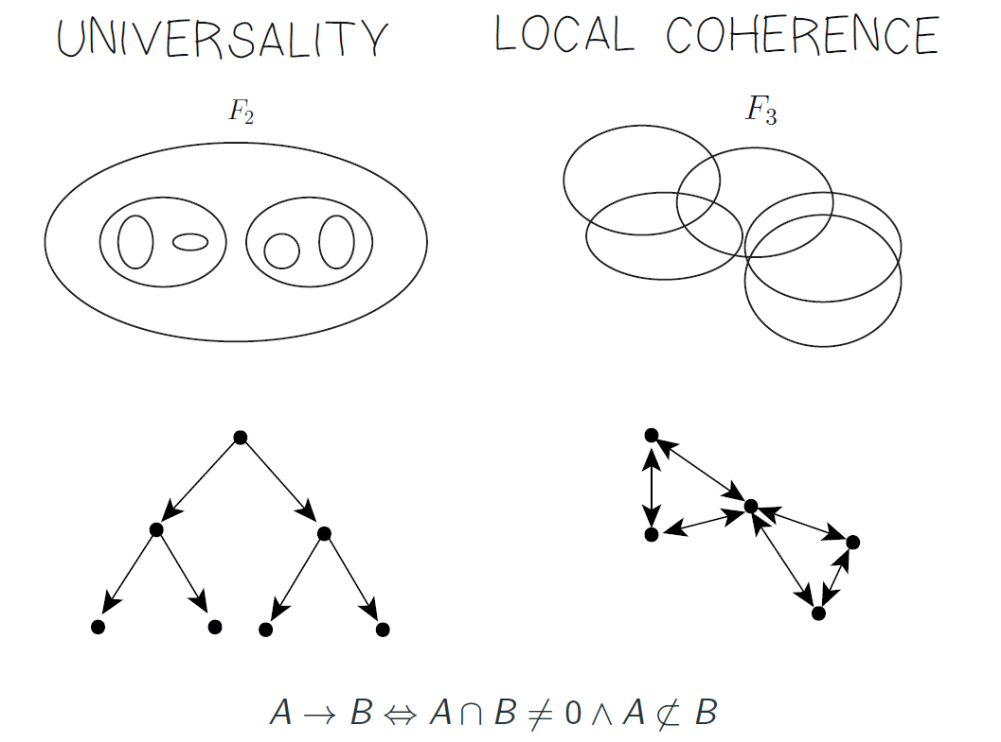
Sets are actually a way of categorizing, because we choose which elements form a set, and which don’t. This difference in categorizing leads to a different way of thinking. Some like to focus on a universality; they prefer one big all-encompassing something, that can be divided in several smaller elements. A hierarchical way of making sets. In science, this is, for example, the idea that you need to have one big thesis split and worked out into several smaller ideas. In political struggle, it is the idea that one struggle is the most important (for example the economical struggle), and that other oppressions are the consequence of that one oppression (for example that sexism, racism,… is only an effect of economical oppression). This idea is often prevalent in Marxist circles. Another way of thinking focuses on local coherence: ideas or elements can be coherent between themselves without forming an all-encompassing whole. Exactly because there is more interdependence than in a hierarchical structure where elements are only connected through top elements, this creates more coherence. This is for example the idea that different struggles can reinforce each other.
But there can also be hierarchy while the relation looks symmetrically locally, in the way in which this relation is embedded in the bigger network. That’s why it can also be interesting to look to undirected networks. The basic idea here is that in a hierarchy, the ‘lower’ elements are only connected with each other through a ‘higher’ element. In a hierarchical network elements with little connections cluster together (they do not have acquaintances their neighbours do not have), while elements with a lot of connections connect different clusters.
In fact we can bring this back to sets, by looking to the sets of neighbours of elements. In a hierarchy the sets formed by the least connected elements are the basic clusters. Different clusters form a bigger cluster, connected through an element with more links. These different bigger clusters tangle together into an even bigger cluster. Until we have one big cluster of all elements, all connected through the top element. This thus corresponds with our representation of hierarchy as sets. In a non-hierarchical structure on the other hand, every element has acquaintances which its neighbour doesn’t have. This corresponds to overlapping sets of acquaintances. The way we represented non-hierarchical structures.
The three ways in which we defined hierarchy, thus correspond with each other. These are hence three different ways to represent the same concept.
Yeah, math! [4]
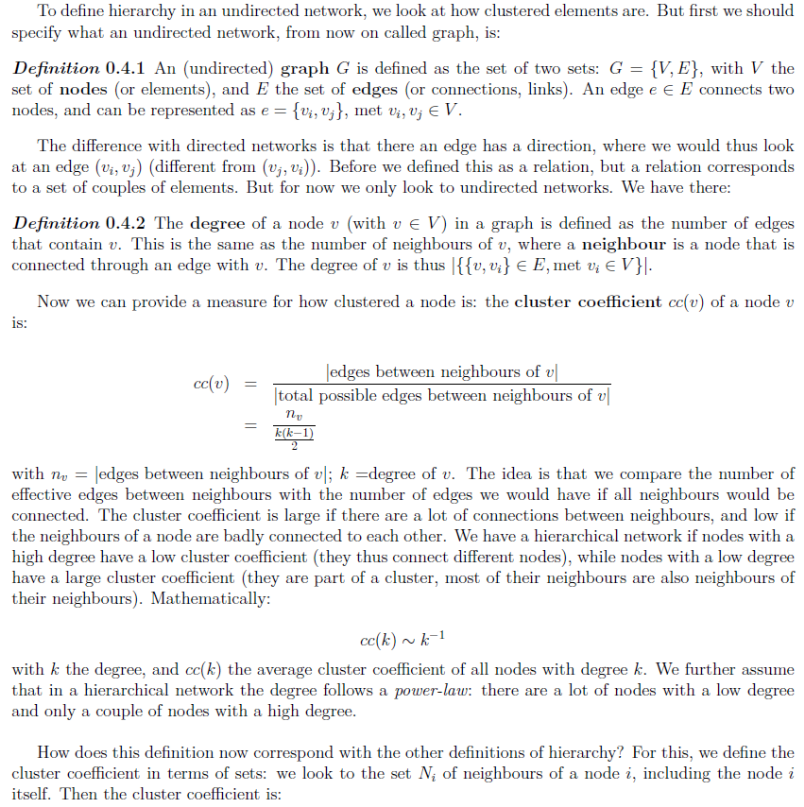
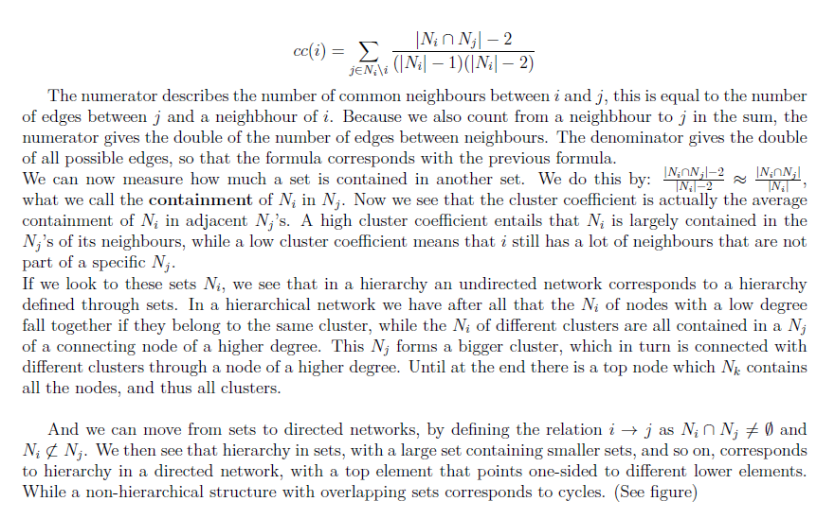
This last way of representation can also give inspiration of how a structure can change. If elements of different clusters directly connect, they bypass the top element, getting different input than that from the top element, hence making the structure less hierarchical.
To summarize, I’ve analysed hierarchy here both functionally and structurally and noticed that there is an accordance between the two. In a hierarchy there is anti-symmetry and every element has maximally one influence. This anti-symmetry causes a power-over relation: there is influence on an element without that element having influence back. Such a relation causes dependence, making one vulnerable for coercion, where you are forced to do something you do not want to do. Coercion differs from constraint, the limitation of possibilities. Having one influence makes that you can be determined by this influence. Internal and/or external control settles whether the output is determined by you and/or an external source.
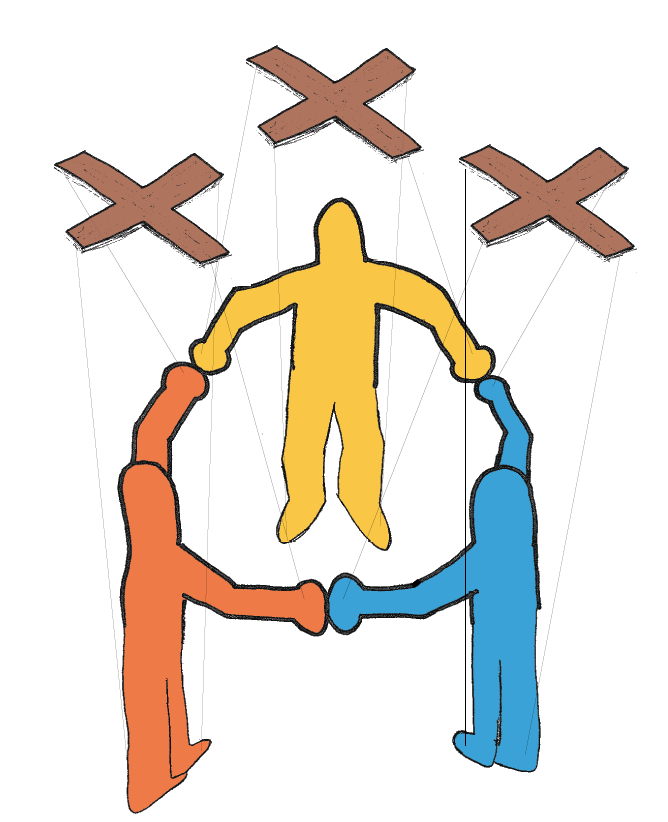
Change
But how do certain constellations emerge? This is important to know, so that we can recognize and avoid the mechanisms that bear hierarchy.
Self-organization
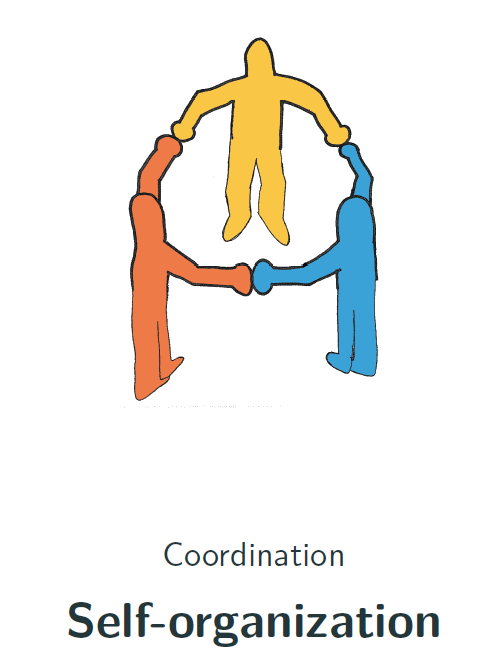
Self-organization can be defined as local interactions that generate a global pattern. In general this happens by coordination between elements (for example individuals): they work together to reach their personal goals better. The purpose is pretty clear, together you can do more than alone. Coordination can happen by alignment: elements adapt to the direction of their neighbours, so that all elements point in the same direction – take as example a magnet. In this way friction is avoided, where elements counteract each other. Synergy happens when collaborating delivers more than the sum of the parts. Elements don’t need to have the same goals for coordination – they can also advance each other’s goals.
Concrete methods for coordination without top-down control will be discussed in the next chapter (‘Rooting out hierarchy’).
Formation of a control mechanism
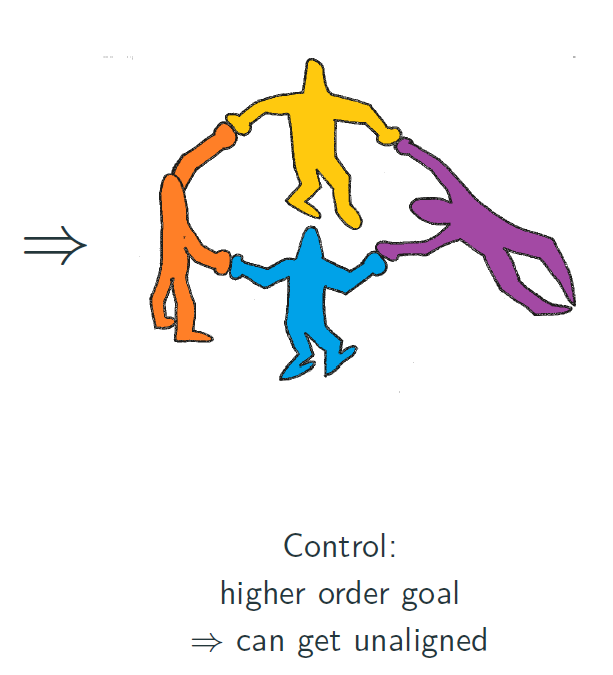
This global pattern emerging from coordination can however become a global goal. And a goal entails a control-mechanism: actions are done to bring the situation closer to that goal. A higher-order system thus originates, an organism with its own goals. This is how we emerged from different cells, but this is also how organisations come into being. This higher-order system starts to exist on its own, only interested in reaching its own goals. The personal goals of the elements that originally formed this higher goal, are pushed to the background and can thus become more and more disconnected. The elements are purely in function of this higher goal (from the point of view of the larger system). Maybe the larger system can do things which are good for the elements, but this happens purely as a coincidence. For example, we don’t care that much about our individual cells, and will in certain circumstances even destroy them if it is better for our organism as a whole.
If we look to organisations, we see that they are often formed around a common goal. However, the longer the organization exists, the more the organization keeps on existing just for the sake of the organization, while it is less and less clear for the participants what they get out of it. And still, they often fail to leave.
In our head such a mechanism also plays, this is how an idee fixe forms. First there is a creative process with all kinds of ideas, where an idea serves you and helps you forward. But after a while you start to serve that idea, you cling to it, even if it no longer helps you. This is how addictions are maintained: because something brought joy in the past or worked to deal with certain situations, you keep on doing it, even if it stopped working long ago.
Often there is thus not one source of all evil, not one leader that caused coercion, but hierarchy comes from the whole or an aspect of the whole. It is in the way that things are structured, that hierarchy can emerge and be maintained.
In social power, power is exerted by the whole social fabric, instead of one individual. It is because everyone does things a certain way, that it is difficult to do something else. But by joining, you contribute to this social power. Think about social norms. There are visions on power that claim that it is always social.
Determination and co-evolution
There are roughly two possible kinds of interaction between a system and its elements (or more in general between two systems): determination and co-evolution. To explain this, let’s look to the evolution of an organism in an ecosystem. The classical view of evolution tells that the organism adapts to find an as fit as possible situation. Here there is what I call determination: the individual is being influenced by the system, while the system itself remains the same. There is thus one-directionality.
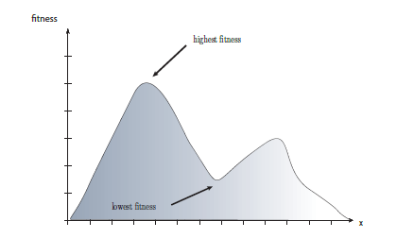
In practice there is however often co-evolution: by the acts of the organism, the ecosystem changes. The organism is, after all, part of that ecosystem. By running around in the ‘fitness-landscape’, the organism changes that landscape, so that certain situations become more or less fit than before. With co-evolution the influence thus happens in two directions.
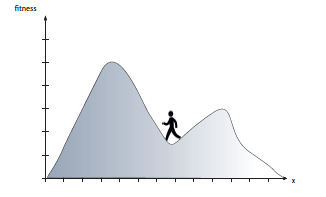
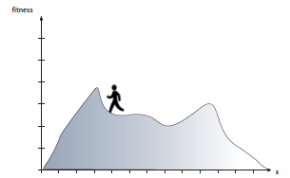
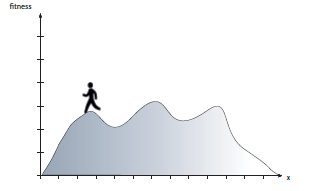
Humans are an extreme example of co-evolution, as we completely formed our ecosystem: our culture, our technology, our social structures,... That’s why the “survival of the fittest” argument used by some capitalists doesn’t really hold: certain people are in this society the ‘fittest’ (mainly because they happen to have a lot of money), but if we would build another social structure, that would no longer be the case.
This difference can be spanned under our common thread. Determination assumes after all a hierarchical structure, where a higher order system completely determines the elements under it. There is an emphasis on universality, searching for one main cause where everything else can be brought under. With co-evolution however, there are cycles of mutual influence. There is a network full of differences, where exactly these differences bring fourth a dynamic and life. Think for example on how many religions assume the world is created by one god, while under scientists the idea lives that the world had formed itself through evolution (variation and selection).
Rooting out hierarchy
These two visions on evolution also give rise to two perspectives on how hierarchy can disappear.
For those believing in determination, change can only happen by changing the larger whole.
This is reflected, for example, in the Marxist view that the material basis must first be changed to bring cultural change. Hence because technologies and with that economic al circumstances change, the social structure also changes.
If co-evolution is however brought up, it is also taken into account that social structures influence technologies and economies. There is thus a focus on that a human can indeed change something, that there is human agency in the process, and things don’t just happen behind our back.
Constant opposition
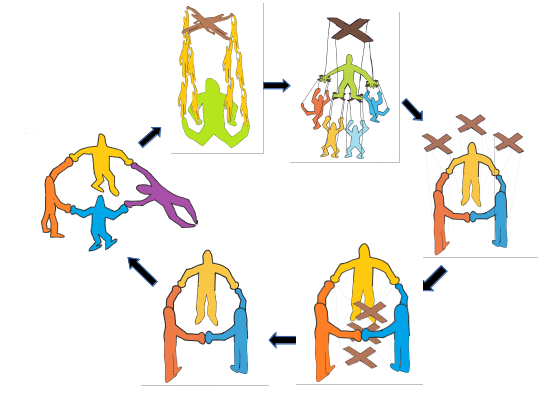
In line with this second vision, I formulate a mechanism to avoid hierarchy which I call constant opposition. The idea is that hierarchy can not emerge if there is a mechanism that roots out every seed. It thus demands constant active effort to recognize and stop hierarchy. Of course this is still vague on how exactly it can be stopped, but recognizing the different manifestations and not contributing to them, but on the contrary do the opposite, is already a lot. Spreading this practice and inspiring others do do the same, brings you even further. Therefore, we’ll go further into some general mechanisms in the following, to apply them in a struggle against hierarchy.
A story:
Mechanisms to expel power in different cultures
Different authors have described mechanisms used in certain cultures to resist hierarchy. Gelderloos argues in his “Rise of Hierarchy” [3] that hierarchy emerges wherever there was no organization to prevent it, and not because of certain technological or societal circumstances. This is affirmed by the existence of hierarchical hunter-gatherer societies (under the form of patriarchy and gerontocracy) and egalitarian agricultural societies. Agriculture thus did not cause hierarchy, though it did reinforce it. And the steam engine already existed in the first century, where it was just a gadget on parties to automatically open doors. It was only centuries later, when the social circumstances where different, that it effectively caused an economical change[5].
An example of a mechanism used to avoid hierarchy, is found with the Mbuti, a pretty gender-free society. They had a ritual-game to resolve gender tensions. It started as a typical tug of war, with men and women on opposite sides. But as soon as one side was winning, someone from the winning team moved to the other side. At the end everyone changed gender multiple times.
Boehm[8] also investigates mechanisms used in different egalitarian societies to discourage hierarchical behaviour. He mentions methods ranging from public opinion through criticism, ridicule and disobedience, to extreme sanctions like exile and execution.
James C. Scott[10] describes communities that had social organization that has been carved
to discourage states to annex. Actually hierarchy is contested everywhere it emerges[9] .
The animal world also does not just let itself be determined by its biology [6] . Chimpanzees and bonobos are biologically quite similar, but their social organization is completely different. Bonobos are quite peaceful, they have frequently sex as a social bonding mechanism and females have a lot of influence. Chimpanzees, on the other hand, are male-dominated, and aggression and domination play a large role, usually by one alpha-male. In some primates the expelled males form homosexual bonds that overthrow the alpha-male.
There is thus also social evolution, where individuals adapt to the social circumstances.
Antifragility
Antifragility is a characteristic a system can meet: it is when the system gets stronger through shocks instead of being weakened by it. Of course the reaction of the system also depends on the nature and strength of the shock.
Take, for example, our body: by coming into contact with germs, we develop antibodies and can handle the illness better next time. Vaccines are based on this principle. An expression of antifragility in social movements is if they grow due to repression. A lot of insurrections and revolutions start from a repressive event, for example the murder of Alexis Grigoropoulos with the Greek riots in 2008, or a street vendor that burns himself after police violence with the Arabic Spring. Underlying is often a general discontent and strong social movement. But how is antifragility possible? Therefore, we should look to a couple of mechanisms.
Variation and selection
Variation and selection is kinda the same principle as trial and error: a variation of possibilities is tried out, and the best ones are selected. Natural evolution is based on this: an organism makes variations of itself and peers through reproduction, and those that are best adapted to survive, will remain. This simple mechanism can thus bring fourth a fantastic complexity.
Order from noise is a manifestation of this: this is when a more ordered state is selected by adding variation, noise. Take, for example, a bucket of stones where by shaking the bucket, the stones will take less place and thus be more ordered. Antifragility can be reached in this way: the shocks can be seen as variation, as noise, and by being exposed to it, the system can find a better configuration. The opposite effect is the noise from order principle. This is what happens if you try to control everything too much. Because of this you won’t have a lot of variation in your inputs, so that you won’t know how to deal with them if you do get other inputs. So by sealing yourself too much, you no longer know what to do if something does manage to penetrate your shield. So that trying to control everything paradoxically leads to less control.
Diversity of tactics can be linked to this principle. This is the idea that a diversity of action methods is used, where everyone does what she thinks is best. Nobody thus tries to convince others to all use the same method. And exactly this combination of tactics often works better than any method separately – in this way different fronts can be attacked at the same time. By using a variety of tactics, it can be investigated which one works best. Of course that is also still needed: a selection of the methods that work, not clinging to methods. There should thus also be enough room for criticism and discussion to improve or give up existing methods.
In general there is always a trade-off between variation and selection (for example in divergent versus convergent thinking): too much variation without selection makes that good situations can’t expand, while too much selection compared to variation causes that a lot of (possibly good) possibilities are never considered.
Positive en negative feedback
Positive feedback is when a deviation gets amplified. In short, when A → B and B → A. That causes that when there is a little bit of A, B is produced, causing more of A. In this way, there will be more and more of A.
This is also what causes the butterfly-effect: when a small difference brings a big effect. The classical metaphor is that the flapping of the wings of a butterfly in Brazil can cause a tornado at the other end of the world.
Revolutions and insurrections are often a manifestation hereof: a small act can trigger shockwaves of bigger and bigger change, like we noted with the Arab Spring or the Greek riots of 2008. Revolutionaries are often looking for both the acts that trigger such cascades as the creation of circumstances so that small deeds can grow to big changes.
But positive feedback isn’t always positive. It is also the cause of the gap between rich and poor. A small difference in income leads to a difference in possibilities, also the possibility to earn more money. In this way, those that already have more money, get even more, while those who had less, get less and less (‘the rich getting richer’ effect). In general, positive feedback is the cause of a power-law: a function where a small portion of elements have large values, while most elements have small values. A constant opposition can counteract such inequality, by systematically taking only from those that have most.
A vicious circle is a manifestation from a positive feedback, for example by being stuck in certain trains of thought, like the alcoholic-credo: “I drink because I feel bad, and I feel bad because I drink.”
Negative feedback, on the other hand, is when a deviation gets weakened. In short: A → B,
B → not A. Thus, more A generates more B, but this more B induces less of A. This brings an equilibrium, where every deviation gets brought back to the original state. Effective repression works in this way: if someone does something that is illegal (A), he gets punished (B), so that he no longer dares to do it (B → not A).
But repression often doesn’t work, and that is for one because a punishment provokes discontent, so that that person will do even more illegal things (B → A). Here there is thus a positive feedback, where repression generates more illegal activities. Or like we noted before, how attempting to have more control can lead to less control.
Negative feedback is what is often used to reach a goal: deviations from a goal value are counteracted.
Neither positive nor negative feedback is therefore always good or bad, the thing is mostly to recognize these feedbacks and stimulate or create the wanted feedback.
Attractor
The dynamics of systems can be investigated by looking which states the system takes successively. An attractor is a set of states where the system ends up. Once in the attractor, you can’t get out: you can go to other states within the attractor, but this will never lead to a state outside the attractor. There can be different attractors, depending on the starting position.
Attractors generate constraints: they make that possibilities are confined. But you only stay within the attractor as long as the rules of the system remain unchanged – due to a disturbance from outside, the system can be kicked out of an attractor.
You can use this to model how a system ends up in a rigid structure, an attractor, but also how to get out of it by constant opposition, regularly shaking the system.
Stigmergy
A method to coordinate without top down control or even the need to be at the same place or time, is stigmergy. This is when traces are left in the environment, where others build on. The origin of this concept was to describe ants that could move very efficiently by following the pheromones of other ants. The shorter the path, the more it can be passed in the same amount of time, and thus the more pheromones can be left. In this way, the shortest path is quickly found. Another example is Wikipedia, where people successively build on an article.
Social struggles often spread through stigmergy: people are inspired by an action they see, they learn a new method and are thus motivated to take action themselves. We see that international (solidarity) actions can often take place without people ever having to meet – they speak to each other through their acts.
This is more or less the idea of propaganda of the deed, where ideas are spread by acting accordingly. This is strongly linked to direct action, where people act directly to change things, instead of taking detours by for example asking the state or media for change. Goals and methods are aligned – you do not use a method that goes against your goal or values. Thus, the opposite of “the goal justifies the means”.
Under the common thread
All these methods and principles are closely linked and can also be spanned under our common thread. In general, it’s about creating a sort of ecosystem of social struggle, with cycles causing autopoiesis, so that struggles blow back oxygen to themselves and reinforce each other. Depending on the situation negative or positive feedback cycles can be built in. Positive feedback so that small acts can grow to big changes. Against every seed of power, there is, however, constant opposition – a negative feedback. Through a broad variety of methods, the best methods can be chosen, and these methods can reinforce each other and be combined. With local coherence between goals, instead of considering one goal as the most important and the rest subordinate. Coordination then happens locally, through stigmergy.
This is also important for mental health: often there are burn-outs because people remain stuck in actions and struggles, without having the feeling that there is something coming out of it. We thus have to take care that people get energy from actions, so that there is a sustainable cycle and the energy doesn’t get exhausted.
From beginning to end... to a new beginning
We can also find tips to fight hierarchy in other parts of this booklet. By avoiding one-directionality, but on the contrary build in cycles and co-evolution. By forging ties directly with individuals from all corners, instead of going through a higher middleman. By not aiming for universality but creating local coherence between our ideas. By focussing on internal control over your situation, instead of always trying to bend the world to your will. By seeing freedom as a decision, and not as a right given to you. By focusing on what you can change as an individual and search for this.
May these ideas inspire you to get started yourself and do your own thing with it – because they are no more than a new beginning.
Citations
In the first place this booklet is based on my PhD thesis:
Busseniers, E. Self-organization versus hierarchical organization – a mathematical investigation of the anarchist philosophy of social organization. (2018).
I further refer in this booklet to a couple of works – these were not necessarily the most important for my work, but they are those I use most directly here.
[1] Maturana, H. R. & Varela, F. J. Autopoiesis and cognition: The realization of the living. vol. 42 (Springer Science & Business Media, 1991).
[2] Corominas-Murtra, B., Goñi, J., Solé, R. V. & Rodríguez-Caso, C. On the origins of hierarchy in complex networks. Proc. Natl. Acad. Sci. 110, 13316–13321 (2013).
[3] Gelderloos, P. The Rise of Hierarchy. (2005).
[4] Barabási, A., Dezső, Z., Ravasz, E. & Oltvai, Z. Scale-free and hierarchical structures in complex networks. SITGES Proc. COMPLEX Netw. 1--16 (2003).
[5] Bookchin, M. History, Civilization, and Progress: Outline for a Criticism of Modern Relativism. Green Perspect. 29, 4–5 (1994).
[6] Roughgarden, J. Evolution’s rainbow: Diversity, gender, and sexuality in nature and people. (Univ of California Press, 2013).
[7] Dittrich, P. & Fenizio, P. S. di. Chemical Organisation Theory. Bull. Math. Biol. 69, 1199–1231 (2007).
[8] Boehm, C. Hierarchy in the Forest: The Evolution of Egalitarian Behavior. (Harvard University Press, 2009).
[9] Graeber, D. Possibilities: Essays on hierarchy, rebellion and desire. (AK Press, 2007).
[10] Scott, J. C. The art of not being governed: An anarchist history of upland Southeast Asia. (Yale University Press, 2009).





